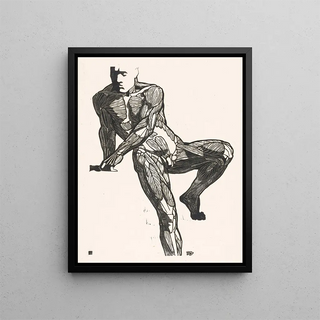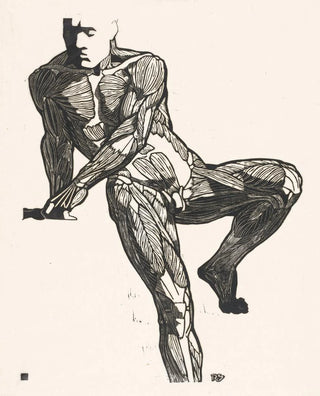Art print | Anatomical study of the muscles of the chest, abdomen, and legs of a man - Reijer Stolk


View from behind

Frame (optional)
Anatomical study of the muscles of the chest, abdomen, and legs of a man - Reijer Stolk – Captivating introduction
The artwork titled "Anatomical study of the muscles of the chest, abdomen, and legs of a man" by Reijer Stolk stands as a true ode to the beauty of the human body. Through this meticulous study, the artist manages to capture the very essence of anatomy, blending art and science in a delicate harmony. This representation is not merely a stylistic exercise but a profound exploration of the shapes and structures that compose our body. Stolk, as an artist, invites us to contemplate this masterpiece with both an analytical and admiring gaze, revealing the complexity and elegance of human musculature.
Style and uniqueness of the work
Stolk's work is distinguished by its precision and attention to detail. Every muscle, every curve, is depicted with an accuracy that demonstrates a deep understanding of human anatomy. The choice of shadows and lights enhances the three-dimensionality of the composition, bringing this study to life. The artist uses a palette of subtle shades that accentuate the texture of the skin and muscular definition, creating a piece where realism marries refined aesthetics. The way he articulates the different parts of the body shows remarkable technical mastery, making this study an emblematic example of the genre. Moreover, Stolk manages to infuse a certain poetry into this representation, transforming what could be perceived as a simple academic exercise into a celebration of the human form.
The artist and his influence
Reijer Stolk, although less known than some of his contemporaries, has made a place for himself in the pantheon of artists who have explored anatomy through their art. His work is rooted in a tradition dating back to the Renaissance, a period during which artists began to combine scientific observation with creativity. Stolk follows this lineage, drawing inspiration from the masters who preceded him while bringing his own vision. His influence is felt not only in the field of art but also in artistic education, where his studies are used as

Matte finish

View from behind

Frame (optional)
Anatomical study of the muscles of the chest, abdomen, and legs of a man - Reijer Stolk – Captivating introduction
The artwork titled "Anatomical study of the muscles of the chest, abdomen, and legs of a man" by Reijer Stolk stands as a true ode to the beauty of the human body. Through this meticulous study, the artist manages to capture the very essence of anatomy, blending art and science in a delicate harmony. This representation is not merely a stylistic exercise but a profound exploration of the shapes and structures that compose our body. Stolk, as an artist, invites us to contemplate this masterpiece with both an analytical and admiring gaze, revealing the complexity and elegance of human musculature.
Style and uniqueness of the work
Stolk's work is distinguished by its precision and attention to detail. Every muscle, every curve, is depicted with an accuracy that demonstrates a deep understanding of human anatomy. The choice of shadows and lights enhances the three-dimensionality of the composition, bringing this study to life. The artist uses a palette of subtle shades that accentuate the texture of the skin and muscular definition, creating a piece where realism marries refined aesthetics. The way he articulates the different parts of the body shows remarkable technical mastery, making this study an emblematic example of the genre. Moreover, Stolk manages to infuse a certain poetry into this representation, transforming what could be perceived as a simple academic exercise into a celebration of the human form.
The artist and his influence
Reijer Stolk, although less known than some of his contemporaries, has made a place for himself in the pantheon of artists who have explored anatomy through their art. His work is rooted in a tradition dating back to the Renaissance, a period during which artists began to combine scientific observation with creativity. Stolk follows this lineage, drawing inspiration from the masters who preceded him while bringing his own vision. His influence is felt not only in the field of art but also in artistic education, where his studies are used as






